Did you know that ads influence 90% of purchase decisions on Google search?1 Search engines present an incredible opportunity for businesses to reach millions of new customers every day—and search engine marketing (SEM) gives you a shortcut straight to the top.
SEM is a digital marketing strategy that increases a website’s visibility in search results through paid ads. As a pay-per-click (PPC) advertising method, SEM is a fast and cost-effective way to instantly boost visibility in search results and drive more traffic to your website.
In this guide, we explain all there is to know about search engine marketing and how it can help your business grow.
Table of Contents:
What Is Search Engine Marketing (SEM)?

Search engine marketing, or SEM for short, is an advertising strategy that focuses on making your website more visible in search engine results pages (SERPs) through targeted ads. In the digital marketing industry, SEM is also commonly called paid search marketing and pay-per-click marketing.
SEM allows businesses to appear on page 1 of search results when potential customers are actively looking for relevant information, products, or services. This strategy works on a pay-per-click model, meaning you only pay when someone clicks on your ad.
This cost-effective approach ensures that your advertising budget is only spent on engaged users who are most likely to convert into customers.
SEM vs. SEO: What’s the Difference?
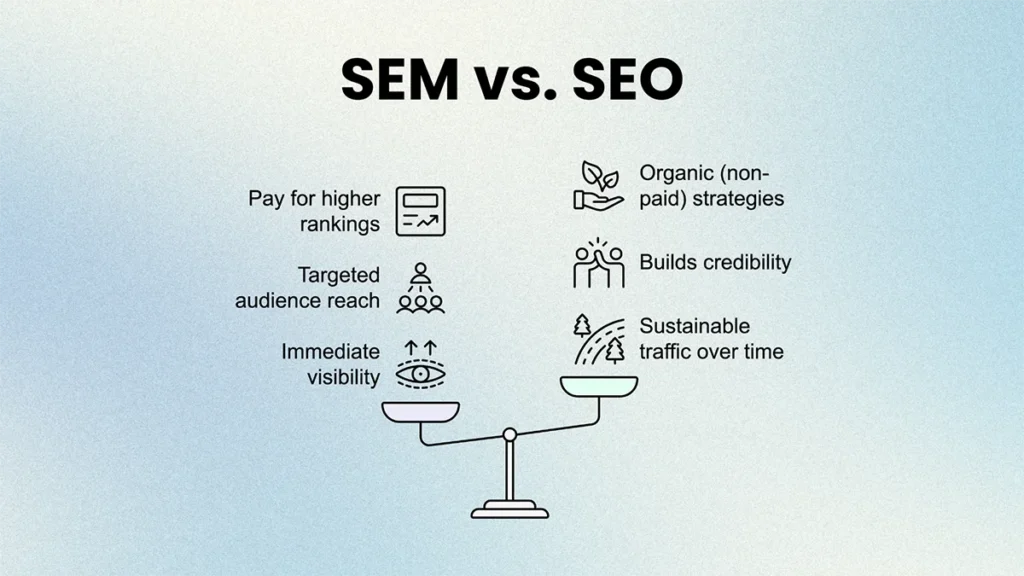
While SEM and search engine optimization (SEO) share the same goal of increasing a website’s visibility in search results, their approaches are very different:
Search Engine Marketing (SEM) uses paid ads to immediately place a business at the top of search results. Businesses bid on keywords, and when users search for those terms, their ads appear as sponsored listings above all organic search results.
Search Engine Optimization (SEO) focuses on organic (nonpaid) strategies to improve a website’s rankings in search results. This includes optimizing website content, structure, user experience, and more to align with search engine algorithms. As a long-term strategy, SEO increases visibility and sustains high rankings without paid ads.
Here’s a table showing the key differences between SEM and SEO:
| SEM | SEO | |
|---|---|---|
| Cost | Pay-per-click (PPC) ads: businesses pay every time someone clicks on the ad | Organic traffic (earned, not paid): businesses have no direct cost for clicks or visits to their website |
| Results | Provides immediate visibility in search results | Takes time to build rankings |
| Longevity | Short-term results: promotional visibility stops when ad budget runs out | Long-term results: visibility in search and traffic continues with ongoing optimization |
| Placement | Website appears at the top of search results as a sponsored ad | Website appears in organic search results below paid ads |
| Strategy | Immediate visibility with targeted reach and traffic | Long-term growth, brand authority, and high search ranking sustainability |
While SEO focuses on growing your organic traffic over time, SEM catapults your website higher in SERPs almost immediately. Most businesses, big and small, benefit from using both strategies together, leveraging SEO for sustainable growth and SEM for fast, targeted exposure.
How Does SEM Work?

As we mentioned above, SEM campaigns operate through a pay-per-click (PPC) advertising model, meaning you only pay when a user clicks on your ad in search results.
To get your ad to appear in search, you bid on keywords. When potential customers search for those keywords, your ad appears prominently at the top of SERPs, providing immediate visibility and driving targeted traffic to your website.
To maximize visibility and conversions while staying within budget, SEM campaigns require strategic keyword bidding, audience targeting, and platform utilization:
Keyword Bidding
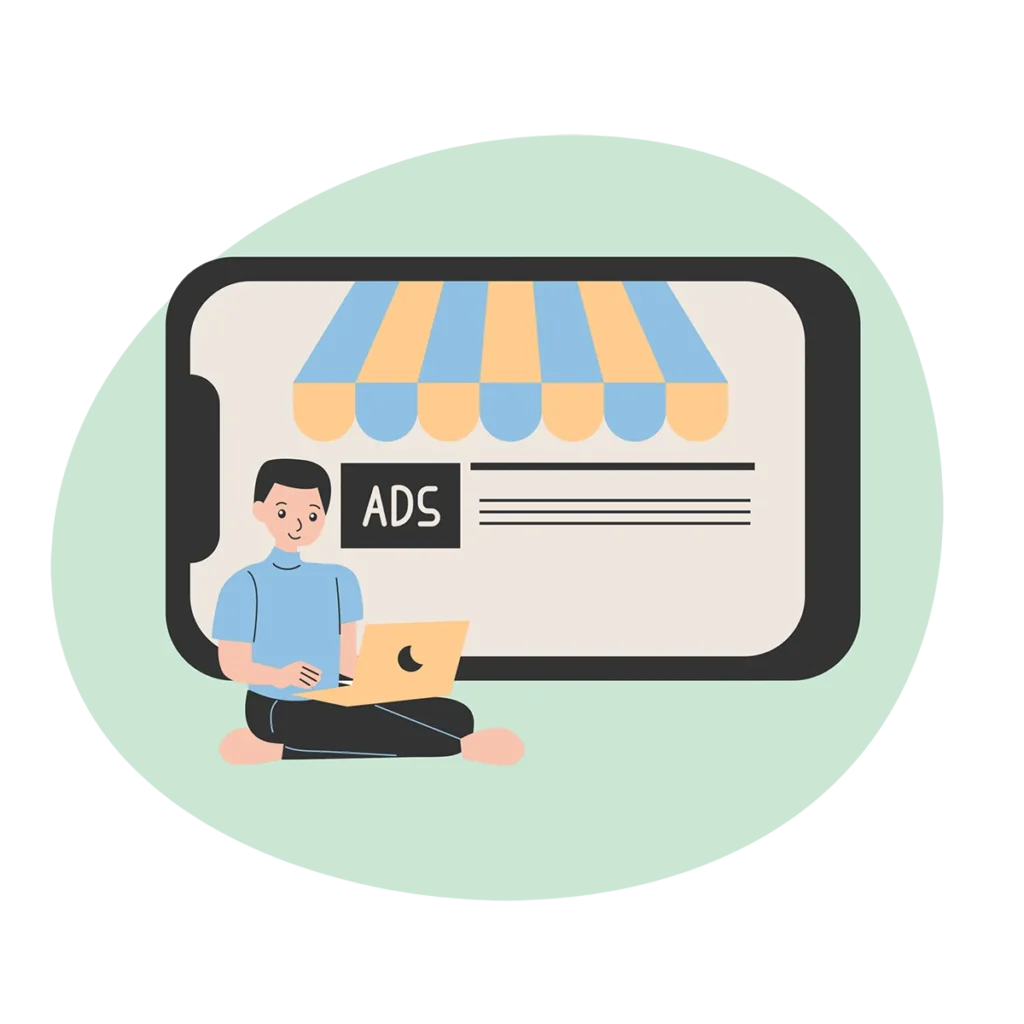
Keywords are the foundation of any SEM campaign. Businesses bid on search terms relevant to their industry, competing with other businesses targeting the same keywords. In search engine marketing, a bid is the highest amount you’re willing to pay for a click.
Your cost per click (CPC) is always going to vary based on keyword competition, industry trends, and audience targeting:
- High-competition keywords generally require higher bids, meaning you’re going to be spending more money per click.
- Meanwhile, low-competition or niche keywords often cost less but are also known to attract highly qualified leads.
Researching and selecting the right keywords is crucial for maximizing your SEM budget and reaching the right audience.
Audience Targeting
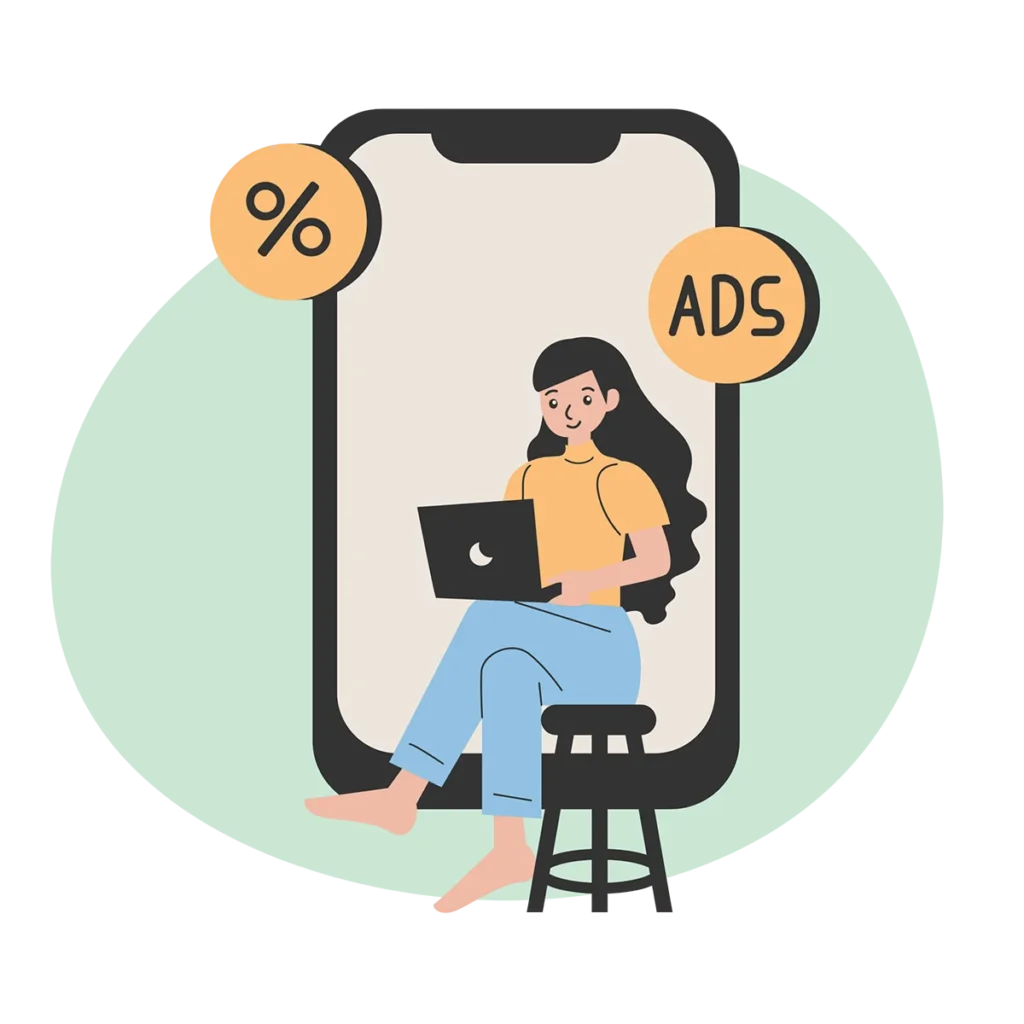
One of the biggest advantages of SEM is the ability to fine-tune your audience targeting. Some of the key targeting methods include:
- Location Targeting: Show your ads to users in specific geographic areas.
- Device Targeting: Adjust bids based on whether users are on desktop, mobile, or tablet.
- Demographic Targeting: Target users based on age, gender, interests, and browsing behavior.
- Remarketing: Target visitors who have interacted with your website previously but didn’t convert.
Using these targeting options strategically helps ensure your SEM ads reach the right audience at exactly the right time.
SEM Platforms
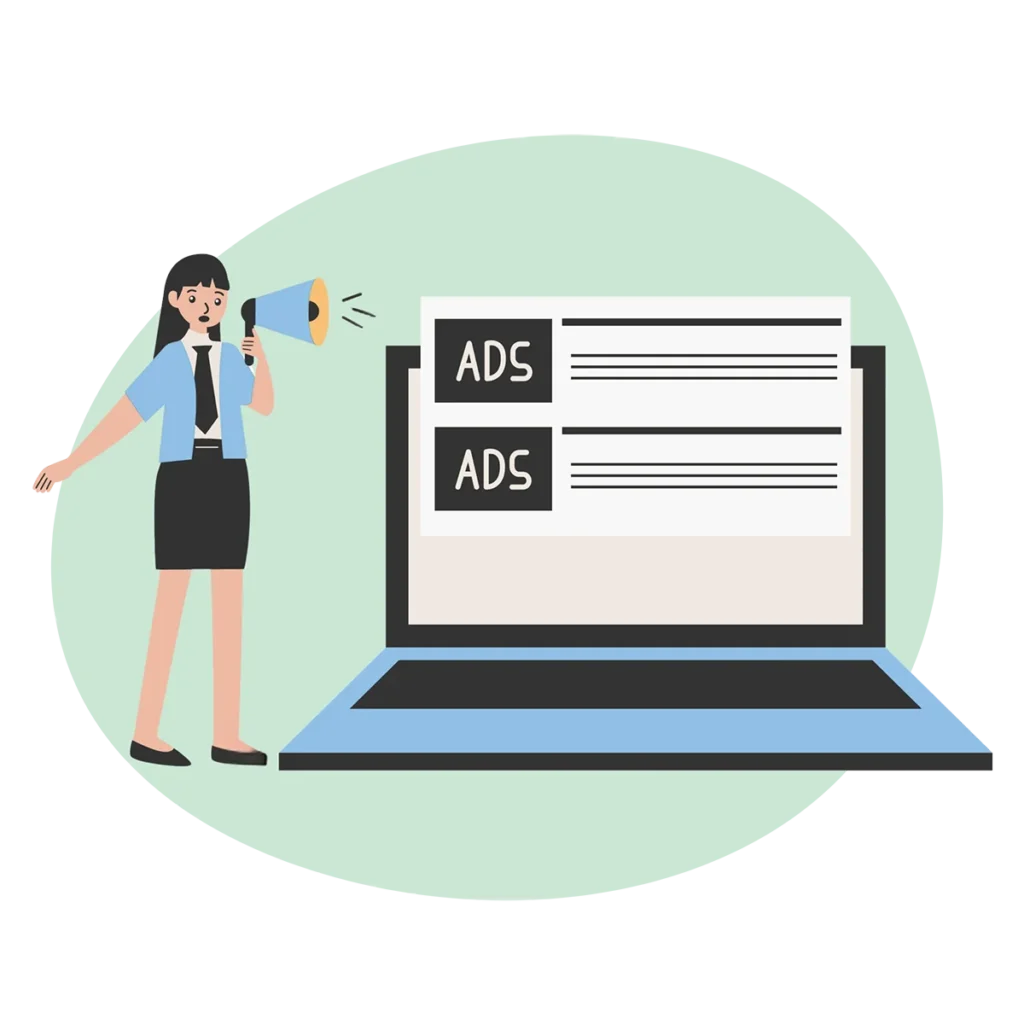
There are several SEM platforms you can use to run PPC campaigns and boost your visibility in search results. Google Ads and Microsoft Advertising are the most widely used:
Google Ads
Formerly known as Google AdWords, Google Ads is the largest SEM platform online. Businesses can pay to have their ads appear on Google’s search results pages, YouTube, and other partner sites. Since the Google search engine dominates the online market, running SEM campaigns here provides access to a vast audience.
Microsoft Advertising
Formerly called Bing Ads, this platform serves ads on Bing, Yahoo, and AOL search networks. Although it may have a smaller user base than Google, Microsoft Advertising can offer lower competition for keywords, resulting in lower bid requirements. It also tends to attract a slightly different audience demographic, making it a valuable strategy for businesses looking to reach new customers.
By leveraging SEM platforms effectively, businesses can create highly targeted ad campaigns that drive immediate visibility in search, increase traffic, and generate high-quality leads.
Types of Search Engine Marketing Ads
SEM platforms like Google Ads offer different types of ad formats, each suited for specific business goals—whether it’s driving website traffic, increasing local visibility, or boosting e-commerce sales.
For businesses, choosing the right ad format depends on your goals, objectives, industry, audience behavior, and more. Below are some of the most common types of SEM ads:
Search Ads
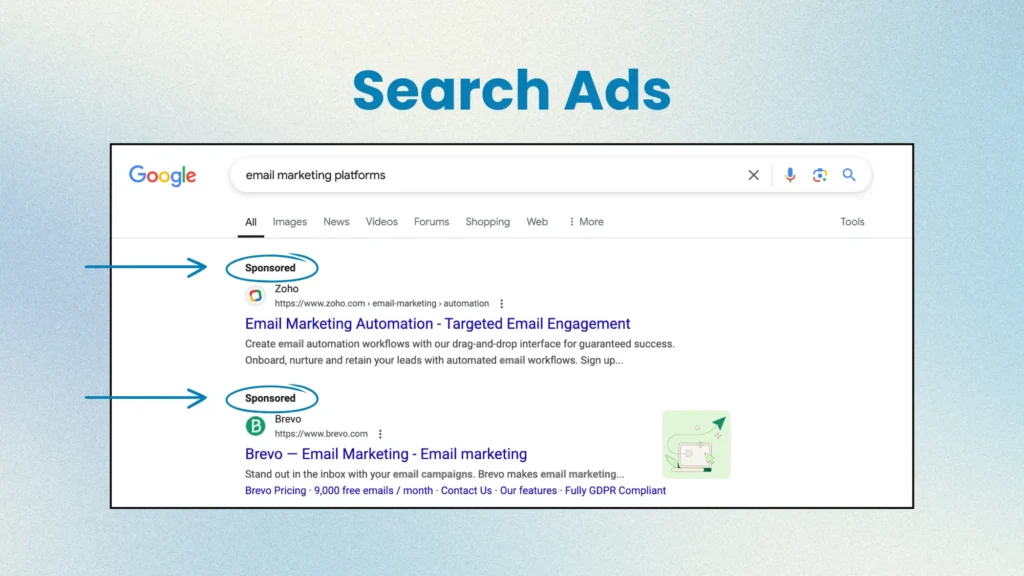
Search ads are the most common type of SEM ad. These are text-based advertisements that appear at the top and bottom of SERPs when users search for specific keywords. They look similar to organic results but are marked as “Sponsored” or “Ad” which helps set them apart.
Since search ads appear to users actively searching for keywords related to information, products, or services, they usually have high conversion potential.
Local Ads
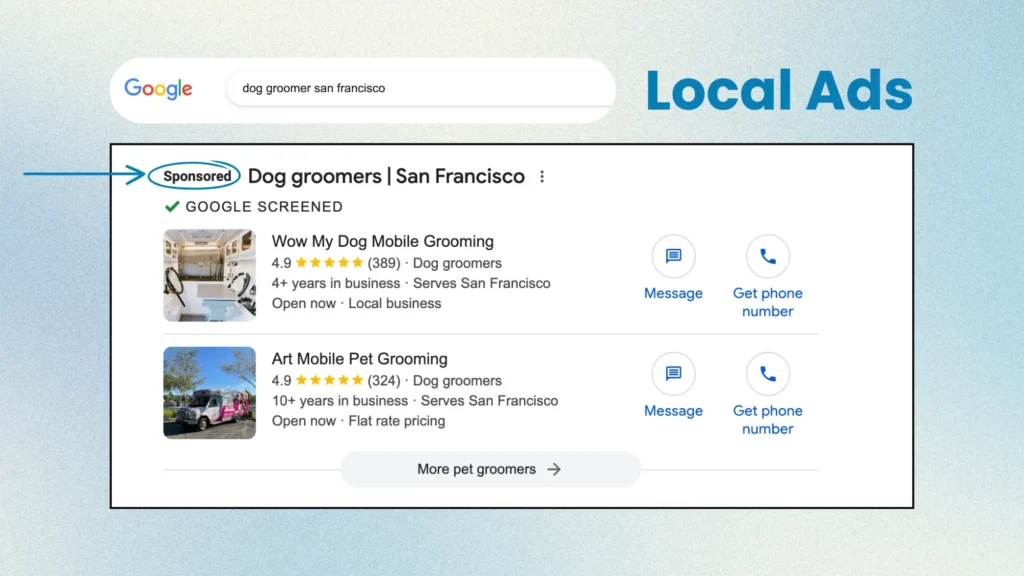
Local ads are particularly effective for brick-and-mortar businesses, service providers, and companies looking to drive foot traffic to a physical location or get local leads. These ads often appear in Google’s Local Pack, Google Maps, and Bing Places when users search for location-based keywords.
For example, a user searching for “dog groomer San Francisco” will see local ads featuring nearby dog grooming businesses, complete with their hours, phone number, customer reviews, and other helpful info.
Shopping Ads

If you’ve ever searched for a product on Google, you’ve probably come across a shopping ad. These are sponsored product listings that appear at the top of search results, displaying product images, pricing, reviews, and even sale information.
Shopping ads are ideal for e-commerce websites looking to boost visibility online and drive product sales.
The Benefits of SEM for Businesses

SEM is one of the most effective ways for businesses to instantly boost their online visibility and reach new customers. It delivers immediate results by placing your business at the top of search results when your target audience is actively searching for what you offer.
Whether you’re a small business or a large enterprise, SEM offers a range of benefits that can help you stay visible and competitive online:
Increased Visibility in Search Results
One of the biggest advantages of SEM is that it places your business in front of your target audience exactly when they are searching for products or services like yours. By utilizing paid advertising, search engine marketing allows you to appear at the top of search results, instantly boosting your brand’s visibility online. This heightened exposure can drive targeted traffic to your website, increasing the likelihood of conversions.
Plus, an added benefit of SEM is that consistent visibility on page 1 of search builds brand recognition and fosters customer trust. Ultimately, this leads to a greater opportunity to capture high-value leads that are most likely to convert and drive sales.
Fast Results
SEM provides immediate visibility in search as soon as your campaign goes live. With the right strategy, businesses can start seeing increased traffic and conversions within days or even hours of launching a campaign.
Targeted Reach
SEM allows you to reach the right audience at exactly the right time. By leveraging targeted keywords, locations, and demographics parameters, businesses can filter out unqualified traffic and focus on high-potential customers.
This refined targeting drives higher conversion rates and maximizes the return on advertising spend, making SEM an incredibly cost-effective marketing strategy for businesses of all sizes.
Measurable Results
SEM campaigns are highly quantifiable, meaning every aspect of a campaign can be tracked and analyzed, allowing businesses to measure performance in real time. You can track key metrics like click-through-rates (CTR), conversions, cost-per-click (CPC), and return on ad spend (ROAS), and make adjustments to maximize results.
This level of transparency enables businesses to refine their strategies, optimize ad performance, and ultimately maximize their marketing budget.
Flexibility and Control
Search marketing platforms like Google Ads, give businesses full control over their SEM campaigns. You can set a daily or monthly budget, pause or adjust campaigns as needed, and modify targeting settings to improve performance with a click of a button.
Whether you want to increase bids for high-converting keywords or experiment with different ad formats, SEM provides the flexibility to adapt to changing business goals and market conditions.
Competitive Advantage
There are almost 6 million Google searches conducted every minute.2 That means your target audience is likely searching for the products or services that offer right now.
A well-optimized SEM strategy helps ensure that your business appears at the top of those search results even if your biggest competitors have strong organic rankings. This means you can immediately attract the attention of your target audience, drive high-quality traffic to your website, and ultimately win more customers.
Boost Your Visibility Online with Search Engine Marketing

Search engine marketing (SEM) is one of the most effective ways to drive targeted traffic to your website, boost brand awareness, and stay ahead of the competition. By leveraging paid search ads, your business can rank higher in SERPs and reach customers at the exact moment they’re looking for the products or services you can provide.
At West County Net, we have years of experience helping businesses big and small create SEM strategies that drive powerful results. Whether you’re new to search marketing or refining your existing strategy, our SEM specialists have the knowledge and skills to help your business thrive online.
Fill out the form below to contact us today!
"*" indicates required fields
References
- Powertraffick. (2024, December 5). Google Ads Statistics. PowerTraffick. https://www.powertraffick.com/google-ads-statistics
- Jones, P., Skopec, C., & Lahey, C. (2024, January 11). 34 Eye-Opening Google Search statistics for 2024. Semrush Blog. https://www.semrush.com/blog/google-search-statistics/
